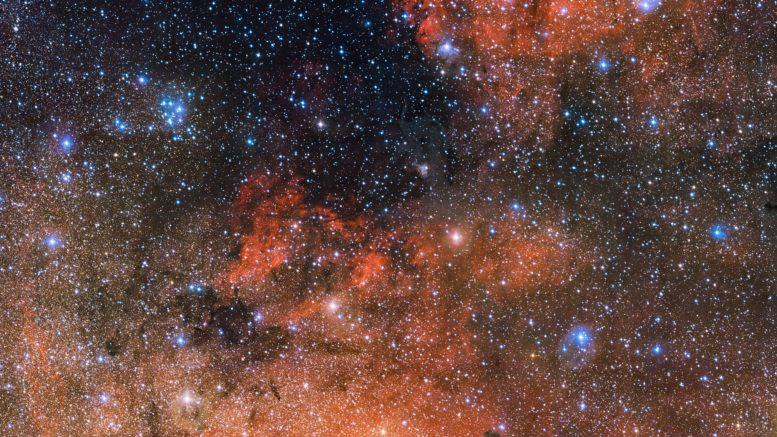It looks like Messier 18 might very well be a binary cluster that is paired with NGC 6618. NGC 6618 located inside Messier 17. Messier 18 is a relatively dim open star cluster located in the constellation Sagittarius.
| Description | |
| Visible From Pacific Northwest | April To August |
| Best Time To Observe | June, July, or August |
| Minimum Size Of Viewing Device | Binoculars |
| Object Type | Open Cluster |
| Designations | Messier 18, M18, NGC 6613, C 1817-171, MWSC 2892 |
| Right Ascension | 18h 19.9m |
| Declination | -17°08′ |
| Constellation | Sagittarius |
| Apparent magnitude | 7.5 |
| Apparent dimensions | 9′ |
| Object Radius | 9 light years |
| Distance From Earth | 4,900 light years |
History
M18 was one of Charles Messier’s original discoveries, which took place in 1764. He would record the following when cataloging the object.
“In the same night [June 3 to 4, 1764], I have discovered a bit below the nebula reported here above, a cluster of small stars, environed in a thin nebulosity; its extension may be 5 minutes of arc: its appearances are less sensible in an ordinary refractor of 3 feet and a half [FL] than that of the two preceding [M16 and M17]: with a modest refractor, this star cluster appears in the form of a nebula; but when employing a good instrument, as I have done, one sees well many of the small stars: after my observations I have determined its position: its right ascension is 271d 34′ 3″, and its declination 17d 13′ 14″ south.”
Charles Messier when recording his sighting of Messier 18
Locating M18 In The Sky
he easiest way to find M18 with binoculars is to first locate Messier 17 and then aim slightly south, or to find Messier 24 and aim about two degrees north. The cluster is easy to resolve even in small telescopes and best seen with low magnification.
Messier 18 can also be located using Kaus Borealis, Lambda Sagittarii, the top star of the Teapot asterism in Sagittarius. The cluster lies 8.5 degrees north and slightly west of the star.

Viewing M18
The star cluster is best to observe in small telescopes, which reveal just over a dozen relatively bright stars. Stars in the cluster are not very concentrated, so M18 doesn’t look as impressive in larger instruments. The cluster contains about 20 members. With a diameter of 0.2 degrees, it appears relatively loose and scarcely populated.
Photographing M18
As with any cluster of stars, precise auto guiding will be crucial as making sure the stars are crisp is crucial to any image. There aren’t a plethora of guides available for those looking to specifically imaging M18, as the best one could potentially find would be on astrobin or astropixels. It is definitely possible with a modified DSLR, but will require a telescope with guiding to track M18.
Sources And Further Reading
Descriptions of all of Messier Objects can be found here.
https://freestarcharts.com/messier-18

Be the first to comment on "Messier 18"